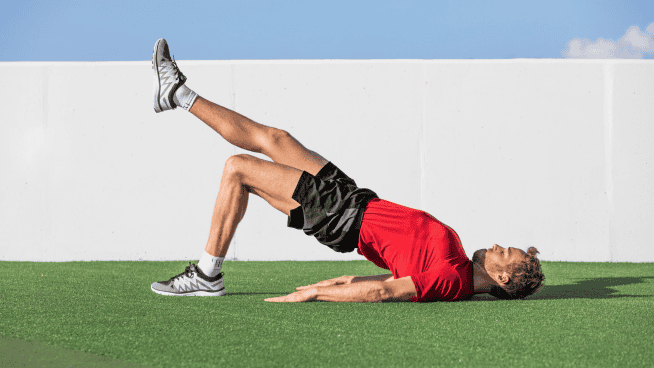How to Get Recruited for College Football This Year
![]()
Just as a coach prepares a game plan for every opponent, an athlete needs a plan to maximize each month of 2016. The following is a football player’s guide to enhancing athleticism and exposure to get recruited by a college program. This is based on my experience as a football player who played in college and made it to the pros, and as a coach who has helped many athletes get recruited to play in college.
The plan below provides a specific timeline and goals you should strive to achieve during certain periods of the year. This will maximize your performance on the field and improve your odds of gaining the attention of college coaches and getting recruited.
No one ever achieved anything great alone. Your success will be a team effort. Rely on the help of your family, your coaches, your trainers, your teachers and your counselors to help you achieve your goals! I am here to help as well. Any questions you have on Twitter: @JRNiklos.
RELATED: How to Create a Recruiting Video That Coaches Will Watch
Stage 1: As Soon As Possible
Athleticism:
- Learn proper movement mechanics, such as running, jumping and change of direction.
- Learn proper strength training technique, especially on core lifts such as the Bench Press, Squat and Deadlift.
- Minimize any deficiencies and overcompensations in your body. For example, if your right leg is stronger than your left, focus on single-leg exercises to balance out your strength. Or if your hamstrings are especially tight, put in extra effort to improve flexibility of this muscle.
Exposure:
- Create your highlight video from last season. Select 10-15 of your best plays, starting with your very best play. Make whoever watches it want to know more about you.
- Your Twitter, Facebook and even Instagram should be used as an athletic résumé. Be sure your name can easily be found with your highlight link, class, position and school in your bio. Don’t post anything a coach or parent wouldn’t want you to post.
College Prep:
- Register with the NCAA Eligibility Center.
RELATED: 3 Tips for Writing a Strong College Recruiting Mission Statement
Stage 2: January-February
Athleticism:
- Prioritize setting a strong athletic foundation by committing yourself to getting stronger in the gym.
- Do general speed, core strength, and plyometric movements. Start with low-intensity exercises with an emphasis on form.
- Train complete athleticism, not just football-specific drills.
Exposure:
- Attend winter exposure events. Do your research to make sure an event is beneficial in helping you get your name out to college coaches. Know what is expected of you at these events so you can ensure you give the best impression.
College Prep:
- Meet with your counselor and be sure to let him/her know you would like to play NCAA sports. He/she will make sure you are scheduled to take the proper classes.
Stage 3: March-April
Athleticism:
- Compete in a spring sport to maintain a competitive edge and cross-train your body.
- Now that your mechanics are set and your foundation is strong, increase the intensity of your training.
- Add variables to your training such increasing resistance or prioritizing single-leg movements over bilateral movements.
Exposure:
- Track and Club 7-v-7 are not only great for your overall development, but each can help with exposure.
- Track provides a college coach with verified speed numbers, and Club 7-v-7 keeps your name in front of national recruiting media.
College Prep:
- Plan ACT and prepare for the test. Most athletes take the ACT their junior year.
- Research colleges. Find at least five schools of all levels (FBS, FCS, D-II, D-III and NAIA) that would be a good fit both athletically and academically.
RELATED: 3 Most Common College Recruiting Mistakes High School Students Make
Stage 3: May-June
Athleticism:
- Start to incorporate more football-specific movements into your training.
- Agility drills should become a priority. Emphasize first-step explosive movements with low center of gravity and movement against resistance.
- Learn and practice drills and techniques used at Combines done at college showcases and camps, including the 40-Yard Dash, Pro Agility, Vertical Jump, etc.
Exposure:
- Attend camps and showcases hosted by colleges and universities. Do your research and select 3 or 4, at least one out of state. Most big colleges also have smaller colleges attend their camps.
College Prep:
- Take ACT.
Stage 4: July-August
Athleticism:
- Incorporate more position-specific movements into your training. For example, a receiver should start running routes, and a defensive back should work on backpedaling into various turns and breaks.
- Increase football-specific conditioning levels with drills like Interval Sprints. One of my go-to drills is 6 sets of ten 5-second bursts with 30 seconds of rest between sprints and 2-minute rest between sets.
- Emphasize recovery so you don’t go into the season with any ailments.
Exposure:
- Create a database of all the colleges and coaches you came in contact with during the off-season. Follow them on your social media accounts.
College Prep:
- Schedule 2nd ACT (if needed).
Stage 5: September-October
Athleticism:
- Maintain your athleticism with a solid in-season training program. You want to be as strong and fast during the playoffs as you are at the beginning of the season. Do training session similar to what you did during the off-season, just lighten the load (fewer reps, sets, and/or volume).
Exposure:
- After Week 3, create a three-game highlight video with 10 of your best plays. Share this video with the college coaches you came in contact with as well as local/national recruiting media.
College Prep:
- Start to narrow down your college choices. Make sure you are academically eligible for these colleges.
- Decide if you would like to graduate early to enroll in college in the spring and compete in the school’s spring football program. If so, plan your schedule accordingly.
Stage 6: November-December
Athleticism:
- Reset and regenerate your body from the long season.
- Your training should now focus on general athleticism, not anything football-specific.
Exposure:
- Complete your season highlight video and share it with coaches.
- If you do not have any college offers, look into attending senior showcases to explore D-II, D-III, and NAIA options.
College Prep:
- Take ACT (if needed).
- Look into college grants and academic scholarships at the colleges you are interested in attending.
- See if you can take any classes in the spring that will transfer to college credits.
RECOMMENDED FOR YOU
MOST POPULAR
How to Get Recruited for College Football This Year
![]()
Just as a coach prepares a game plan for every opponent, an athlete needs a plan to maximize each month of 2016. The following is a football player’s guide to enhancing athleticism and exposure to get recruited by a college program. This is based on my experience as a football player who played in college and made it to the pros, and as a coach who has helped many athletes get recruited to play in college.
The plan below provides a specific timeline and goals you should strive to achieve during certain periods of the year. This will maximize your performance on the field and improve your odds of gaining the attention of college coaches and getting recruited.
No one ever achieved anything great alone. Your success will be a team effort. Rely on the help of your family, your coaches, your trainers, your teachers and your counselors to help you achieve your goals! I am here to help as well. Any questions you have on Twitter: @JRNiklos.
RELATED: How to Create a Recruiting Video That Coaches Will Watch
Stage 1: As Soon As Possible
Athleticism:
- Learn proper movement mechanics, such as running, jumping and change of direction.
- Learn proper strength training technique, especially on core lifts such as the Bench Press, Squat and Deadlift.
- Minimize any deficiencies and overcompensations in your body. For example, if your right leg is stronger than your left, focus on single-leg exercises to balance out your strength. Or if your hamstrings are especially tight, put in extra effort to improve flexibility of this muscle.
Exposure:
- Create your highlight video from last season. Select 10-15 of your best plays, starting with your very best play. Make whoever watches it want to know more about you.
- Your Twitter, Facebook and even Instagram should be used as an athletic résumé. Be sure your name can easily be found with your highlight link, class, position and school in your bio. Don’t post anything a coach or parent wouldn’t want you to post.
College Prep:
- Register with the NCAA Eligibility Center.
RELATED: 3 Tips for Writing a Strong College Recruiting Mission Statement
Stage 2: January-February
Athleticism:
- Prioritize setting a strong athletic foundation by committing yourself to getting stronger in the gym.
- Do general speed, core strength, and plyometric movements. Start with low-intensity exercises with an emphasis on form.
- Train complete athleticism, not just football-specific drills.
Exposure:
- Attend winter exposure events. Do your research to make sure an event is beneficial in helping you get your name out to college coaches. Know what is expected of you at these events so you can ensure you give the best impression.
College Prep:
- Meet with your counselor and be sure to let him/her know you would like to play NCAA sports. He/she will make sure you are scheduled to take the proper classes.
Stage 3: March-April
Athleticism:
- Compete in a spring sport to maintain a competitive edge and cross-train your body.
- Now that your mechanics are set and your foundation is strong, increase the intensity of your training.
- Add variables to your training such increasing resistance or prioritizing single-leg movements over bilateral movements.
Exposure:
- Track and Club 7-v-7 are not only great for your overall development, but each can help with exposure.
- Track provides a college coach with verified speed numbers, and Club 7-v-7 keeps your name in front of national recruiting media.
College Prep:
- Plan ACT and prepare for the test. Most athletes take the ACT their junior year.
- Research colleges. Find at least five schools of all levels (FBS, FCS, D-II, D-III and NAIA) that would be a good fit both athletically and academically.
RELATED: 3 Most Common College Recruiting Mistakes High School Students Make
Stage 3: May-June
Athleticism:
- Start to incorporate more football-specific movements into your training.
- Agility drills should become a priority. Emphasize first-step explosive movements with low center of gravity and movement against resistance.
- Learn and practice drills and techniques used at Combines done at college showcases and camps, including the 40-Yard Dash, Pro Agility, Vertical Jump, etc.
Exposure:
- Attend camps and showcases hosted by colleges and universities. Do your research and select 3 or 4, at least one out of state. Most big colleges also have smaller colleges attend their camps.
College Prep:
- Take ACT.
Stage 4: July-August
Athleticism:
- Incorporate more position-specific movements into your training. For example, a receiver should start running routes, and a defensive back should work on backpedaling into various turns and breaks.
- Increase football-specific conditioning levels with drills like Interval Sprints. One of my go-to drills is 6 sets of ten 5-second bursts with 30 seconds of rest between sprints and 2-minute rest between sets.
- Emphasize recovery so you don’t go into the season with any ailments.
Exposure:
- Create a database of all the colleges and coaches you came in contact with during the off-season. Follow them on your social media accounts.
College Prep:
- Schedule 2nd ACT (if needed).
Stage 5: September-October
Athleticism:
- Maintain your athleticism with a solid in-season training program. You want to be as strong and fast during the playoffs as you are at the beginning of the season. Do training session similar to what you did during the off-season, just lighten the load (fewer reps, sets, and/or volume).
Exposure:
- After Week 3, create a three-game highlight video with 10 of your best plays. Share this video with the college coaches you came in contact with as well as local/national recruiting media.
College Prep:
- Start to narrow down your college choices. Make sure you are academically eligible for these colleges.
- Decide if you would like to graduate early to enroll in college in the spring and compete in the school’s spring football program. If so, plan your schedule accordingly.
Stage 6: November-December
Athleticism:
- Reset and regenerate your body from the long season.
- Your training should now focus on general athleticism, not anything football-specific.
Exposure:
- Complete your season highlight video and share it with coaches.
- If you do not have any college offers, look into attending senior showcases to explore D-II, D-III, and NAIA options.
College Prep:
- Take ACT (if needed).
- Look into college grants and academic scholarships at the colleges you are interested in attending.
- See if you can take any classes in the spring that will transfer to college credits.
RECOMMENDED FOR YOU
Create A Free Recruiting Profile Today!
CaptainU helps athletes & parents not only be proactive but also to manage and take control of their entire recruiting journey.










